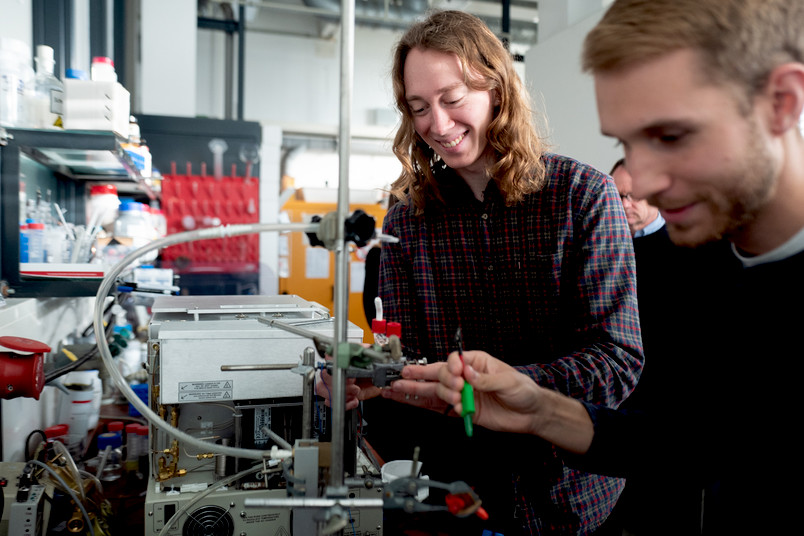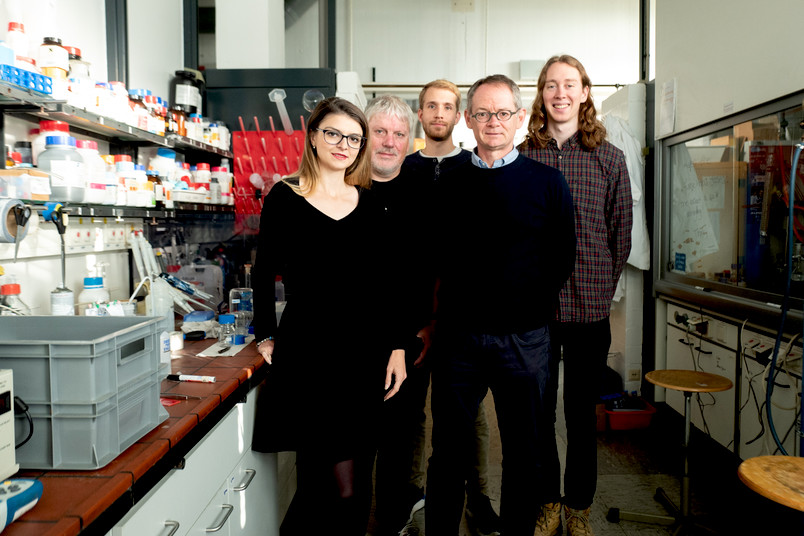Inspired by nature – Converting CO2 to valuable resources with the help of nanoparticles
Enzymes use cascade reactions to produce complex molecules from comparatively simple raw materials. Researchers have now copied this principle

Peter O’Mara from Sydney (on the left) and Patrick Wilde from Bochum working with an electrochemical cell for CO2 reduction © RUB, Kramer
An international research team has used nanoparticles to convert carbon dioxide into valuable raw materials. Scientists at Ruhr-Universität Bochum in Germany and the University of New South Wales in Australia have adopted the principle from enzymes that produce complex molecules in multi-step reactions. The team transferred this mechanism to metallic nanoparticles, also known as nanozymes. The chemists used carbon dioxide to produce ethanol and propanol, which are common raw materials for the chemical industry.
The team led by Professor Wolfgang Schuhmann from the Center for Electrochemistry in Bochum and Professor Corina Andronescu from the University of Duisburg-Essen, together with the Australian team led by Professor Justin Gooding and Professor Richard Tilley, reported in the Journal of the American Chemical Society on 25 August 2019.
“Transferring the cascade reactions of the enzymes to catalytically active nanoparticles could be a decisive step in the design of catalysts,” says Wolfgang Schuhmann.
Particle with two active centres
Enzymes have different active centres for cascade reactions, which are specialised in certain reaction steps. For example, a single enzyme can produce a complex product from a relatively simple starting material. In order to imitate this concept, the researchers synthesised a particle with a silver core surrounded by a porous layer of copper. The silver core serves as the first active centre, the copper layer as the second. Intermediate products formed at the silver core then react in the copper layer to form more complex molecules, which ultimately leave the particle.
In the present work, the German-Australian team showed that the electrochemical reduction of carbon dioxide can take place with the help of the nanozymes. Several reaction steps on the silver core and copper shell transform the starting material into ethanol or propanol.
“There are also other nanoparticles that can produce these products from CO2 without the cascade principle,” says Wolfgang Schuhmann. “However, they require considerably more energy.”
The researchers now want to further develop the concept of the cascade reaction in nanoparticles in order to be able to selectively produce even more valuable products such as ethylene or butanol.

Research team: Corina Andronescu, Wolfgang Schuhmann, Patrick Wilde, J. Justin Gooding and Peter O’Mara (from left) © RUB, Kramer
About the University Alliance Ruhr
Since 2007, the three Ruhr region universities have been engaged in close strategic cooperation under the umbrella of the University Alliance Ruhr (UA Ruhr). By pooling their strengths, the partner institutions are systematically expanding their output. There are now over 100 cooperations in the fields of research, teaching and administration, all built on the principle of being “better together”. With over 120,000 students and almost 1,300 professors, the UA Ruhr is one of the largest and best-performing hubs for science and technology in Germany.
Funding
The work was financially supported by the German Research Foundation within the framework of the Cluster of Excellence Resolv (EXC 2033, project 390677874), the European Research Council within the Horizon 2020 programme (grant number 833408), the German Academic Exchange Service within the framework of project 57446293 and the Ruhr University Research school Plus, financed by the German Excellence Initiative (DFG GSC 98/3). Further funding came from the Australian Research Council through the Centre of Excellence in Convergent Bio-Nano Science and Technology (CE140100036) and an Australian Laureate Fellowship (FL150100060), the Discovery Project (DP190102659), and the Mark Wainwright Analytical Centre at the University of New South Wales.
Original publication
Peter B. O’Mara, Patrick Wilde, Tania M. Benedetti, Corina Andronescu, Soshan Cheong, J. Justin Gooding, Richard D. Tilley, Wolfgang Schuhmann: Cascade reactions in nanozymes: spatially separated active sites inside Ag-core–porous-Cu-shell nanoparticles for multistep carbon dioxide reduction to higher organic molecules, in: Journal of the American Chemical Society, 2019, DOI: 10.1021/jacs.9b07310
Source: Ruhr-Universität Bochum, press release, 2019-09-27.
